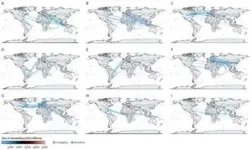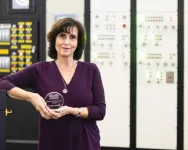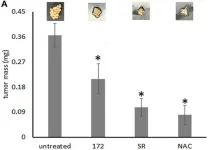(Press-News.org) Fatima Bagheri, a National Science Foundation (NSF) postdoctoral fellow at The University of Texas at Arlington, was one of 75 students selected to attend an intensive program on supercomputing at the Argonne National Laboratory in Chicago.
With support from the Department of Energy’s Exascale Computing Program, Bagheri participated in the Argonne Training Program on Extreme-Scale Computer (ATPESC) aimed at teaching attendees the ins and outs of using the latest supercomputers. Bagheri said she came to ATPESC to expand her knowledge of high-performing computers (HPC) like exascales and learn methods that could advance her research into exoplanets, which orbit stars outside our solar system.
“Deploying our code to exascale machines requires revamping our codebase and adapting it to take advantage of hardware accelerators,” Bagheri said. “I know that is no easy task and could require multiple years of teamwork. I plan to communicate the ideas and tools I learned at ATPESC with my collaborators to lay out a plan toward reaching this goal.”
Born and raised in Iran, Bagheri began her doctoral studies at Sharif University of Technology in Tehran before transferring to the University of Texas at Austin after immigrating to the United States in 2017. She spent a year in Austin as a visiting researcher before coming to UTA to pursue her doctorate in physics. In 2021, Bagheri earned a fellowship from the NSF that included a $200,000 award to fund her study of exoplanets and their magnetic fields.
“The planets’ magnetic fields are essential and required for life as we know it on Earth,” Bagheri said. “Understanding their origins and their interactions with their stellar hosts helps us better access the possibility of extraterrestrial life in the universe.
“This ATPESC workshop offered me a unique opportunity to expand my knowledge of HPC techniques that are highly relevant to my research goals. It allowed me to interact with, network with and seek advice from world experts on these techniques, ultimately leading to better parallel software development practices in my research and open-source libraries to which I contribute.”
Supercomputers like the ones at Argonne can come with a steep learning curve. They must be used with specialized hardware, scientific tools and techniques that are constantly evolving as technology advances. The training provided by Argonne included lectures, hands-on sessions with Department of Energy supercomputers and evening talks. The curriculum included everything from emerging hardware technologies to software development to using artificial intelligence in research applications.
“ATPESC is all about equipping researchers with the skills and knowledge they need to harness the world’s most powerful supercomputers for groundbreaking science and engineering,” said Ray Loy, ATPESC program director and lead for training, debugging and math libraries at the Argonne Leadership Computing Facility.
Founded in 2013 for specialized researchers with some experience in HPC, the Argonne program is designed to help scientists take their skills to the next level. There are no fees for researchers to attend, and they are provided complimentary airfare, meals and lodging.
“If I had a colleague or peer considering applying for ATPESC next year, I would tell to make the most of this unique, once-in-a-lifetime learning opportunity,” Bagheri said.
END
Supercomputing training at Argonne National Laboratory
UTA postdoc attends intensive program that includes hands-on sessions with supercomputers
2023-12-04
ELSE PRESS RELEASES FROM THIS DATE:
Most adults eligible for statins for prevention are not using them
2023-12-04
Embargoed for release until 5:00 p.m. ET on Monday 4 December 2023
Annals of Internal Medicine Tip Sheet
@Annalsofim
Below please find summaries of new articles that will be published in the next issue of Annals of Internal Medicine. The summaries are not intended to substitute for the full articles as a source of information. This information is under strict embargo and by taking it into possession, media representatives are committing to the terms of the embargo not only on their own behalf, but also on behalf of the organization they represent.
----------------------------
1. ...
EMBARGOED: CAR-T not cost-effective as second-line therapy for diffuse large B-cell lymphoma at current prices, study finds
2023-12-04
EMBARGOED: December 4, 2023, 5PM EST
Contact:
Nicole Oliverio, Dana-Farber Cancer Institute
617-257-0454, nicole_oliverio@dfci.harvard.edu
CAR-T not cost-effective as second-line therapy for diffuse large B-cell lymphoma at current prices, study finds
RESEARCH SUMMARY
Study Title: Peripheral blood TCR clonotype diversity as an age-associated marker of breast cancer progression
Publication: Annals of Internal Medicine, Click here for link
Dana-Farber Cancer Institute authors include: Amar H. Kelkar, MD, MPH (first author); Edward R. Scheffer Cliff, MBBS, MPH; Caron A. Jacobson, MD; Gregory A. Abel, MD, MPH; Corey Cutler, MD, MPH (senior author); and Robert Redd, MS.
Summary: Chimeric ...
Strange burn: new research identifies unique patterns in Utah wildfires
2023-12-04
For a century fire ecologists have worked to decipher a complex question — what does a “normal'' wildfire year look like in the West? That’s a hard question to answer for many reasons, but new research from a team in the Quinney College of Natural Resources shows that thanks to the state’s unique landscapes, Utah’s wildfire patterns may never fit into what is considered “normal” for other Western states.
Utah landscapes are diverse — from dense forests of pinyon-juniper to scattered patches of sagebrush and grasslands, Utah’s variable topography produces ...
New study identifies the greatest threat to wildlife across North America and Canada: people
2023-12-04
You see posts like these on neighborhood Facebook pages all the time: “An owl just flew into my window and appears stunned! Help!” or “I found a baby squirrel on the ground after the wind storm last night. Who do I call?” The answer is a local wildlife rehabilitation center—licensed individuals and organizations that take in hundreds of thousands of sick and injured wild animals nationwide each year. Wildlife rehabilitators see the highest number and greatest range of species of any government or nonprofit organization in the country, giving them unique insight into animal health—and making them great bellwethers of what’s ...
ORNL engineer Karen White honored with Lifetime Achievement Award
2023-12-04
Oak Ridge National Laboratory’s Karen White, who works in ORNL’s Neutron Science Directorate, has been honored with a Lifetime Achievement Award.
White, who manages the section that provides the machine controls,, computing infrastructure, and protection systems across all neutron science technical areas, received the award during the biennial International Conference on Accelerator and Large Experimental Physics Control Systems, held October 7-13, 2013, in Cape Town, South Africa. The award by ICALEPCS honors and celebrates an individual or individuals ...
Osteopontin induces mitochondrial biogenesis in deadherent cancer cells
2023-12-04
“Here, we study the induction of mitochondrial biogenesis by Osteopontin variants in deadherent breast tumor cells.”
BUFFALO, NY- December 4, 2023 – A new research paper was published in Oncotarget's Volume 14 on December 1, 2023, entitled, “Osteopontin induces mitochondrial biogenesis in deadherent cancer cells.”
Metastasizing cells display a unique metabolism, which is very different from the Warburg effect that arises in primary tumors. Over short time frames, oxidative phosphorylation and ATP generation are prominent. Over longer time frames, mitochondrial biogenesis becomes a pronounced ...
Boiled bubbles jump to carry more heat
2023-12-04
Water is often the go-to resource for heat transfer, being used in large-scale cooling operations like data centers that power the internet and nuclear power plants that power cities. Discovering dynamic phenomena to make water-based heat transfer more energy and cost efficient is the ongoing work of Jonathan Boreyko, associate professor and John R. Jones III Faculty Fellow in mechanical engineering.
Boreyko and his team have published extensively on the topic of water and the way it can move, with members of his Nature-Inspired ...
Increase in child suicide linked to the nation’s opioid crisis
2023-12-04
The rise in child suicides in the U.S. since 2010 was fueled in part by the nation’s opioid crisis, which previous studies found increased rates of child neglect and altered household living arrangements, according to a new RAND Corporation study.
The analysis links the rise is child suicides to the reformulation of prescription opioids to discourage misuse, which led to a steep rise in the use of illicit opioids such as heroin and may have contributed to the growth of illicit opioid markets.
Geographic areas that were more exposed to ...
UCLA scientists receive $9.1 million from the NCI to improve early detection methods for cancer
2023-12-04
Researchers from the UCLA Health Jonsson Comprehensive Cancer Center have received two grants totaling $9.1 million from the National Cancer Institute to advance liquid biopsy technologies for the early detection of cancer, which can significantly improve treatment outcomes and reduce the number of deaths caused by the disease.
A liquid biopsy is a promising non-invasive medical test using a small volume of blood that gives scientists insight into the genetic makeup of tumors. By analyzing these components, researchers can gain valuable information about the genetic mutations, alterations and other molecular changes associated ...
Health Affairs’ December Issue: Global Lessons From COVID-19
2023-12-04
Washington D.C.—The December Health Affairs, a theme issue about the lessons learned around the globe from the COVID-19 pandemic, covers topics including how modeling was used to respond to the pandemic, how health inequities emerged and were addressed, and how countries tried to protect their vulnerable residents. The December issue of Health Affairs was supported by the Robert Wood Johnson Foundation and the Merck Foundation.
There will be a Health Affairs briefing on Tuesday, December 5, from 11:00 a.m. to 2:00 p.m. ET. Register here.
COVID-19, a decline in FDA foreign facility inspections.
At the start of the COVID-19 pandemic, the Food and Drug Administration (FDA) halted ...
LAST 30 PRESS RELEASES:
Heart-brain connection: international study reveals the role of the vagus nerve in keeping the heart young
Researchers identify Rb1 as a predictive biomarker for a new therapeutic strategy in some breast cancers
Survey reveals ethical gaps slowing AI adoption in pediatric surgery
Stimulant ADHD medications work differently than thought
AI overestimates how smart people are, according to HSE economists
HSE researchers create genome-wide map of quadruplexes
Scientists boost cell "powerhouses" to burn more calories
Automatic label checking: The missing step in making reliable medical AI
Low daily alcohol intake linked to 50% heightened mouth cancer risk in India
American Meteorological Society announces Rick Spinrad as 2026 President-Elect
Biomass-based carbon capture spotlighted in newly released global climate webinar recording
Illuminating invisible nano pollutants: advanced bioimaging tracks the full journey of emerging nanoscale contaminants in living systems
How does age affect recovery from spinal cord injury?
Novel AI tool offers prognosis for patients with head and neck cancer
Fathers’ microplastic exposure tied to their children’s metabolic problems
Research validates laboratory model for studying high-grade serous ovarian cancer
SIR 2026 delivers transformative breakthroughs in minimally invasive medicine to improve patient care
Stem Cell Reports most downloaded papers of 2025 highlight the breadth and impact of stem cell research
Oxford-led study estimates NHS spends around 3% of its primary and secondary care budget on the health impacts of heat and cold in England
A researcher’s long quest leads to a smart composite breakthrough
Urban wild bees act as “microbial sensors” of city health.
New study finds where you live affects recovery after a hip fracture
Forecasting the impact of fully automated vehicle adoption on US road traffic injuries
Alcohol-related hospitalizations from 2016 to 2022
Semaglutide and hospitalizations in patients with obesity and established cardiovascular disease
Researchers ‘listen in’ to embryo-mother interactions during implantation using a culture system replicating the womb lining
How changing your diet could help save the world
How to make AI truly scalable and reliable for real-time traffic assignment?
Beyond fragmented markets: A new framework for efficient and stable ride-pooling
Can shape priors make road perception more reliable for autonomous driving?
[Press-News.org] Supercomputing training at Argonne National LaboratoryUTA postdoc attends intensive program that includes hands-on sessions with supercomputers







